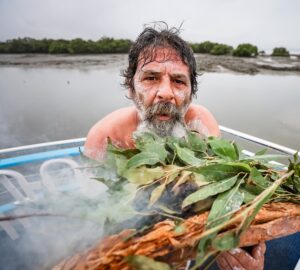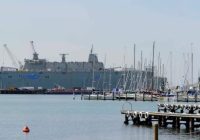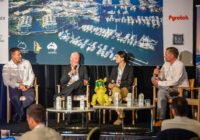Local Worimi Elders conducted what is possibly the first ever traditional smoking ceremony on the water at the official naming of two new oyster reefs in the Port Stephens-Great Lakes Marine Park.

Two new oyster reefs at Port Stephens were officially named by Worimi elders in possibly the first ever traditional smoking ceremony on the water (Photo: Salty Dingo Media)
The new reefs were named Bindayimaguba Ninang and Garuwaguba Ninang, which translates to home of the black possum oysters and sea country oysters, respectfully. The names reflect the Worimi people’s strong cultural connection to Sea Country (Garuwa).
Worimi Elders conducted the smoking ceremony out on the waters of the Marine Park at Karuah, adjacent to one of the new reefs, with stakeholders and community representatives who supported and participated in the project in attendance.
With Australia having lost an estimated 99% of its oyster reefs since colonisation, the restored oyster reefs represent a step to redress this massive historic loss and restore the balance in our estuaries.
The reefs were created as part of the Port Stephens Shellfish Reef Restoration project, the first large-scale shellfish reef restoration project in NSW.
Conducted between 2018 and 2021, the project has restored 7.5 hectares, or 11 soccer pitches, of new Sydney rock oyster reef habitat which has since become home to over 55 million oysters.
DPI Senior Fisheries Manager Oyster Reefs, Charlotte Jenkins, says as well as their cultural significance, the oyster reefs provide a range of benefits to the marine environment, including water filtration, shoreline protection and fish habitat.
“Monitoring work has shown these new reefs are already providing environmental benefits, filtering nearly 7.5 million litres, or 3 Olympic-sized swimming pools, of water an hour.
“The reefs not only provide habitat for different fish species boosting fish numbers, they also help protect the shoreline from erosion during large tides.”
Ms Jenkins said the public who want to learn more about the oyster reef project can access a new video showcasing the project or check out the new signage installed in three strategic locations around the estuary.
Worimi Traditional Owner and NSW DPI Aboriginal Project Officer Marine Estate, Regan Lilley said he is proud to be part of a project that will be there for future generations to come.
“Setting up these reefs to look after water quality is not just a here and now thing, that’s going to be there for the next couple of generations and keep on going after that,” he said.
“The advantages coming back are going to be there for generations to come,” Mr Lilley said.
The reef restoration has been completed by NSW DPI Fisheries under the Marine Estate Management Strategy, in partnership with The Nature Conservancy and the Australian Government through their Reef Builder initiative
Click here to find out more about the Shellfish Reef Restoration project.











